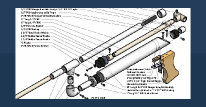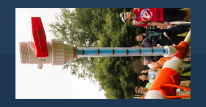Supplies: (all part numbers searchable through McMaster.com)
-8771K12 - Adhesive-Back Felt Bumper 1/2" Diameter, 1/8" Height, Green
-90126A007 - #6 Zinc-plated washers (they don't rust)
-Miter box and hacksaw
-Box cutter/razor blade
-Piece of wood, cardboard, etc. for cutting board
-Hot glue gun/glue OR Goop/E-6000
-"Airgun" barrel material appropriate for your foam of choice
-1/2" diameter foam of your choice
Cutting blanks:
There is one very simple way to make perfect, square cuts every time. Get a piece of tubing that has a loose fit on your darts. You want to be able to feed your foam through it. Cut a slit in the tubing the goes almost all the way through. Use your miter box and hacksaw to get the cut as square as possible. You want to use something that has rather thick walls so your template doesn't fall apart. If you don't cut the slit deep enough, your foam won't be cut all the way. An easy way to check this is to put the razor blade through your slit, hold it up to the light and see if it passes all the way through. Cut the slit however long you want your darts to be from the end of the tube. Use a generous amount of tubing for the template so you have a place to put you're hand when cutting. De-burr the inside of the blank template with some sandpaper wrapped around something that will fit inside the blank template. Now that you're template is done, feed the foam into the end of the pipe furthest away from the slit. Feed until it's flush with the other end of the tube. With a razor blade, cut through the slit. You want to make sure the razor blade is sharp, so the cuts are clean. Feed the foam through again and repeat.

Most effective modification I've done to this method is simply taping the template on your leg. Another idea is to cut multiple slits your template.
Dart Tips:
Now that you're blanks are cut, it's time to make the heads. The most effective way I've found doing this is making the tips before you apply any glue. Peel off one of your felt discs (grabbing towards the edge), and stick it to one of the washers. Make this as centered as possible. After you do a million of these, it becomes pretty easy. Lay your tips felt side down, rinse, and repeat.

Gluing your tips:
After you're tired doing that, you can start gluing the tips on the foam. Now this is where most people fail at making slugs, and generally why they fall apart for most people. It is absolutely critical you burn a hole or cavity in the foam for your glue to sit. All the poorly made slugs I've seen don't have this hole. Most people will just apply whatever glue they're using to the top of the foam, and then put on the tip. These won't last long.
Easiest way to burn holes is with the hot glue gun. Burn your hole as centered as possible, about 3/8” deep by 3/8” wide. You want the entire washer to sit inside the glue cavity after it’s applied. This way you can be sure there isn’t any exposed metal on either side of the dart. Now at this point you can decide whether you want to use hot glue or Plumber's Goop/E-6000.


I'm sure there are more, I just can't think of them. I usually use hot glue because of the ease of use, and I can make way more than using Goop/E-6000. When choosing your hot glue gun, it depends on the density of your foam. When we used to use the gray McMaster foam, they had to be made with a mini-low temp glue gun. The dual-temp or high temp glue guns would melt the foam too fast and deform the sides of the hole or cavity. After getting the hot pink foam, we switched to using a dual-temp glue gun on high. The lower temp glue guns just don’t burn the foam enough to make a good hole. You may need to do a little experimenting here to see what glue gun will work best. I always use the “mini” ones as the larger ones are too hard to burn holes, and dispense too much glue on one pull. Normally I’ll aim for almost one full pull of glue for each dart.
Now, it’s time for the actual gluing. Take your glue of choice and squirt it into the cavity. Turn the blank upside down and smash it into one of your washer + felt tips. You may have to adjust the tip a bit to make sure it’s centered and secured to the foam. Make sure your glue covers the entire washer. With hot glue, fill the hole until it's over the hole by about 1/8". The hot glue will seep in a bit. After that, set it to the side and repeat until you’ve either ran out of tips, or you’re bored out of your mind.

Remember when I told you it's critical you burn a hole?
Here's a couple darts, some of them made with the hole, and some of them while just applying glue on the top.
Good:

Bad:

After dissecting them, you can see the difference.

The darts with holes burned are much more difficult to pull apart with your hands. The other darts on the right, with glue applied only on the top, easily break. Also, the darts with holes burned have no exposed metal, compared to the other darts.
I'd also like to note you can make these with #8 washers instead. I highly recommend against it though for a couple of reasons. If you use CPVC, the washers may be too large to fit through your barrels. Second, there is inherently exposed metal unless you have super thick foam and larger felt pads. It's just not possible for the metal to not be seen from the outside of the dart. I'd honestly like to see #8's go away completely.
Happy dart-making.
Edited by Ryan201821, 26 July 2012 - 04:02 PM.



















